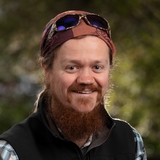Robin Hartley

Contact
- Phone: +64 7 343 5359
- Email: Robin Hartley
- Web: https://nz.linkedin.com/in/robinhartley
- ORCID: 0000-0001-9594-3164
- Team: Data and Geospatial Intelligence
- Role: Geospatial Scientist, Autonomous Systems
About
Robin Hartley is a geospatial scientist who specialises in the development and application of UAV remote sensing to forestry. Having a diverse range of skills covering remote sensing, mensuration, fire fighting, logging, arboriculture and conservation, Robin applies remote sensing techniques across a broad range of disciplines within forestry, including fire research, forest inventory, forest health and forest phenotyping. He has also worked extensively with industry to enable the uptake of UAV technology, and is spearheading the creation of the Tools For Foresters focus group to further democratise UAV technology within the industry.
Qualifications
- BSc, Geography and Environmental Management, University of the West of England, UK - 2011
Research capabilities
- Development of UAV remote sensing techniques for forestry applications
- UAV workflow optimisation
- Development of UAV applications for fire research and firefighting
- Novel UAV operational research (sub-canopy, BVLOS)
Career highlights
- Assistant Research Leader, Geomatics at Scion, October 2019-June 2021
- 2020 Science New Zealand Awards – Team Award (as part of the Geomatics Team)
- 2020 Scion Awards – Health and Safety Award
- 2019 Forest Growers Research Awards – Science of International Quality (as part of the Phenotyping Team from Scion and University of Canterbury School of Forestry)
Selected papers
Hartley, R.J.; Leonardo, E.M.; Massam, P.; Watt, M.S.; Estarija, H.J.; Wright, L.; Melia, N.; Pearse, G.D. An Assessment of High-Density UAV Point Clouds for the Measurement of Young Forestry Trials. Remote Sensing 2020, 12, 4039
Dash, J. P., Watt, M. S., & Hartley, R. J. L. (2019). Testing UAV-borne Riegl Mini VUX-1 scanner for phenotyping a mature genetics trial. Technical Report for GCFF Research Programme, GCFF TN23, Accessed from https://gcff.nz/publications/technical-notes/
Watt, M. S., Buddenbaum, H., Leonardo, E. M. C., Estarija, H. J. C., Bown, H. E., Gomez-Gallego, M., Hartley, R., Massam, P., Wright, L., & Zarco-Tejada, P. J. (2020). Using hyperspectral plant traits linked to photosynthetic efficiency to assess N and P partition. ISPRS Journal of Photogrammetry and Remote Sensing, 169, 406-420.
Watt, M. S., Buddenbaum, H., Leonardo, E. M. C., Estarija, H. J., Bown, H. E., Gomez-Gallego, M., Hartley, R. J., Pearse, G. D., Massam, P., & Wright, L. (2020). Monitoring biochemical limitations to photosynthesis in N and P-limited radiata pine using plant functional traits quantified from hyperspectral imagery. Remote Sensing of Environment, 248, 112003.
Dash, J.P., Watt, M.S., Paul, T.S., Morgenroth, J. and Hartley, R., 2019. Taking a closer look at invasive alien plant research: A review of the current state, opportunities, and future directions for UAVs. Methods in Ecology and Evolution, 10(12), pp.2020-2033.
Scholten, R. C., Hill, J., Werner, W., Buddenbaum, H., Dash, J. P., Gallego, M. G., Rolando, C. A., Pearse, G. D., Hartley, R., & Estarija, H. J. (2019). Hyperspectral VNIR-spectroscopy and imagery as a tool for monitoring herbicide damage in wilding conifers. Biological Invasions, 21(11), 3395-3413.
Hartley, R., 2017. Unmanned aerial vehicles in forestry - reaching for a new perspective. New Zealand Journal of Forestry (2017) 62(1): 31–39
Morley, C. G., Broadley, J., Hartley, R., Herries, D. and McMorran, D., 2017. The potential of using Unmanned Aerial Vehicles (UAVs) for precision pest control of possums (Trichosurus vulpecula). Rethinking Ecology 2: 27-39.
